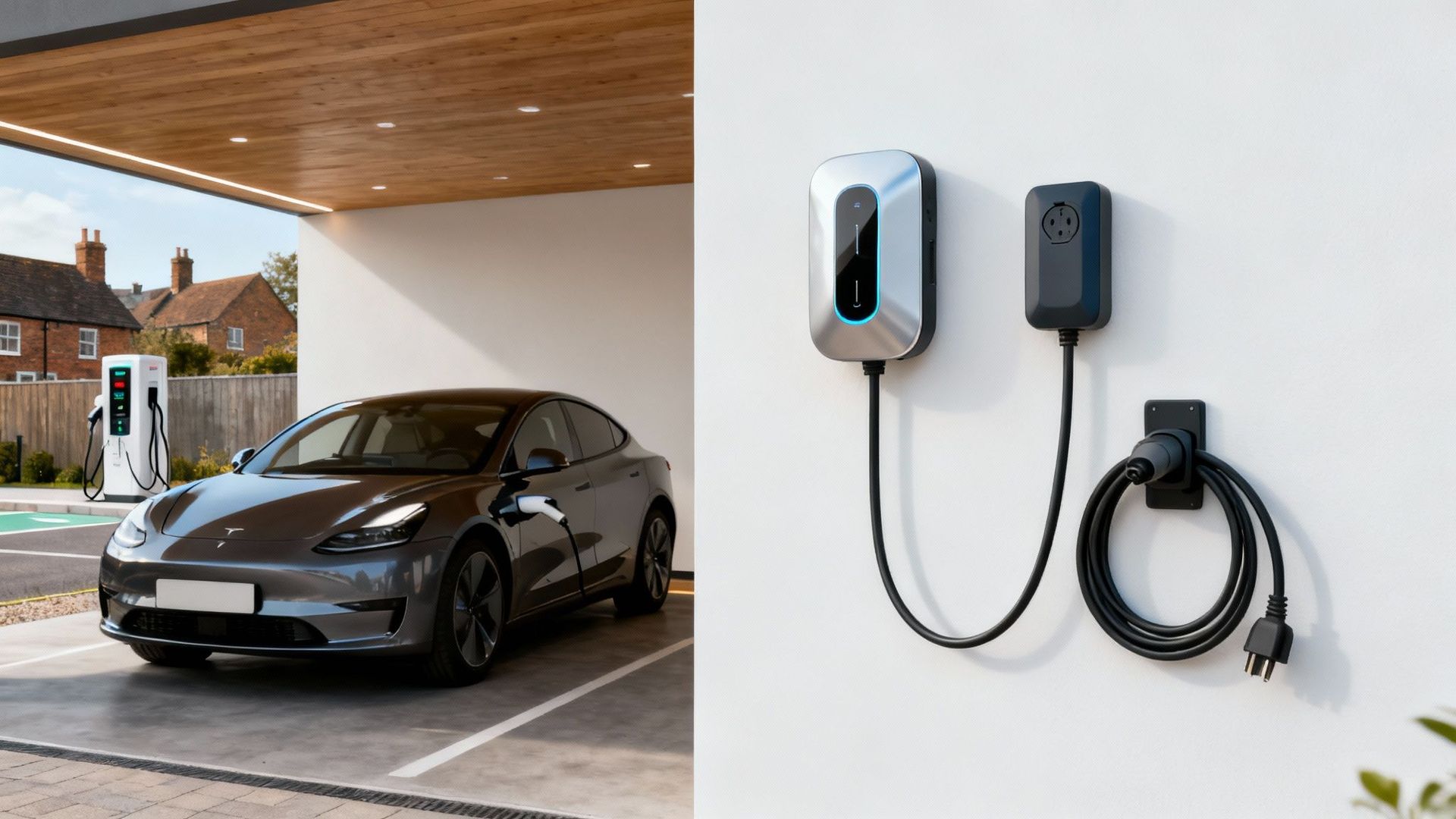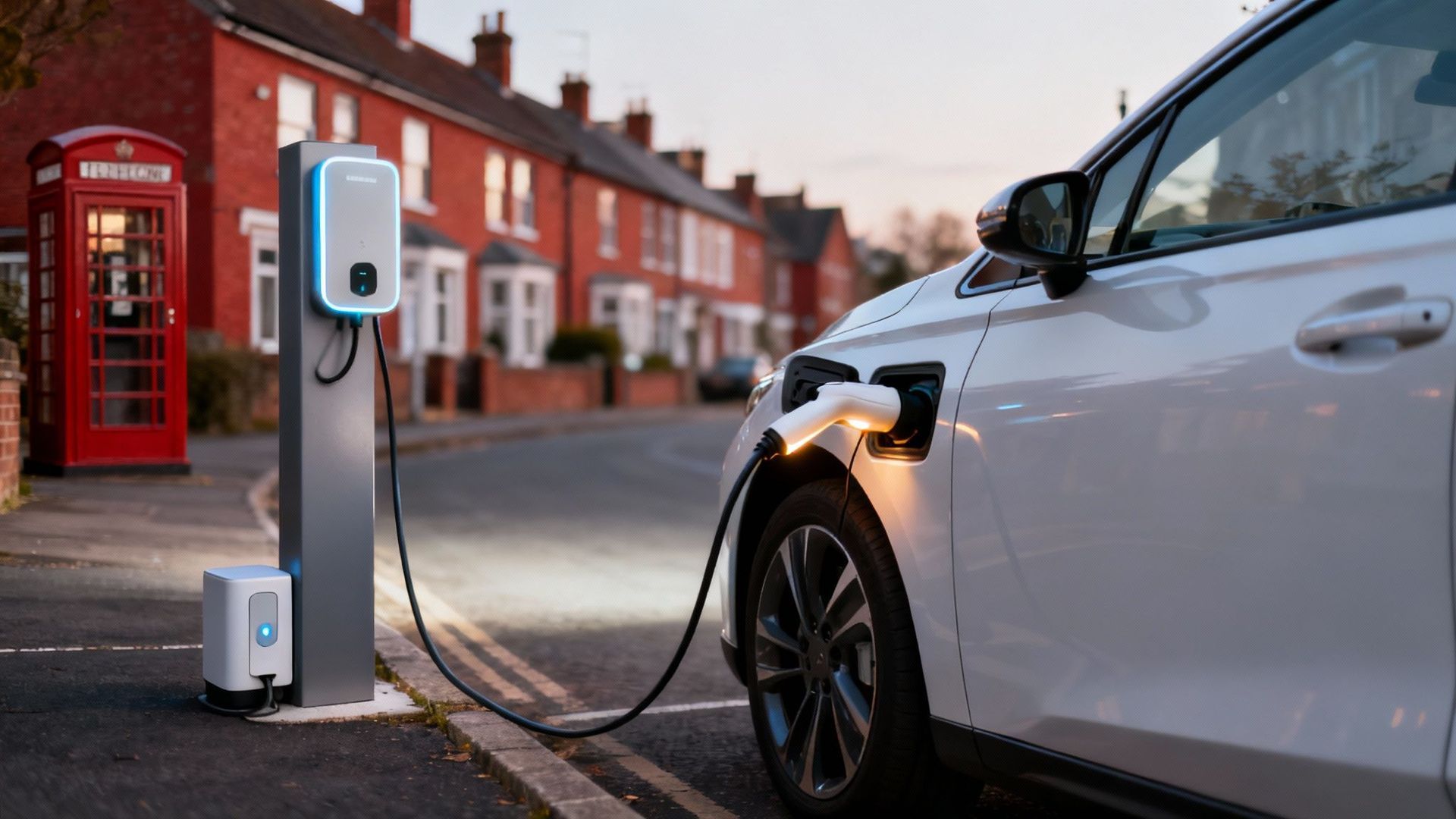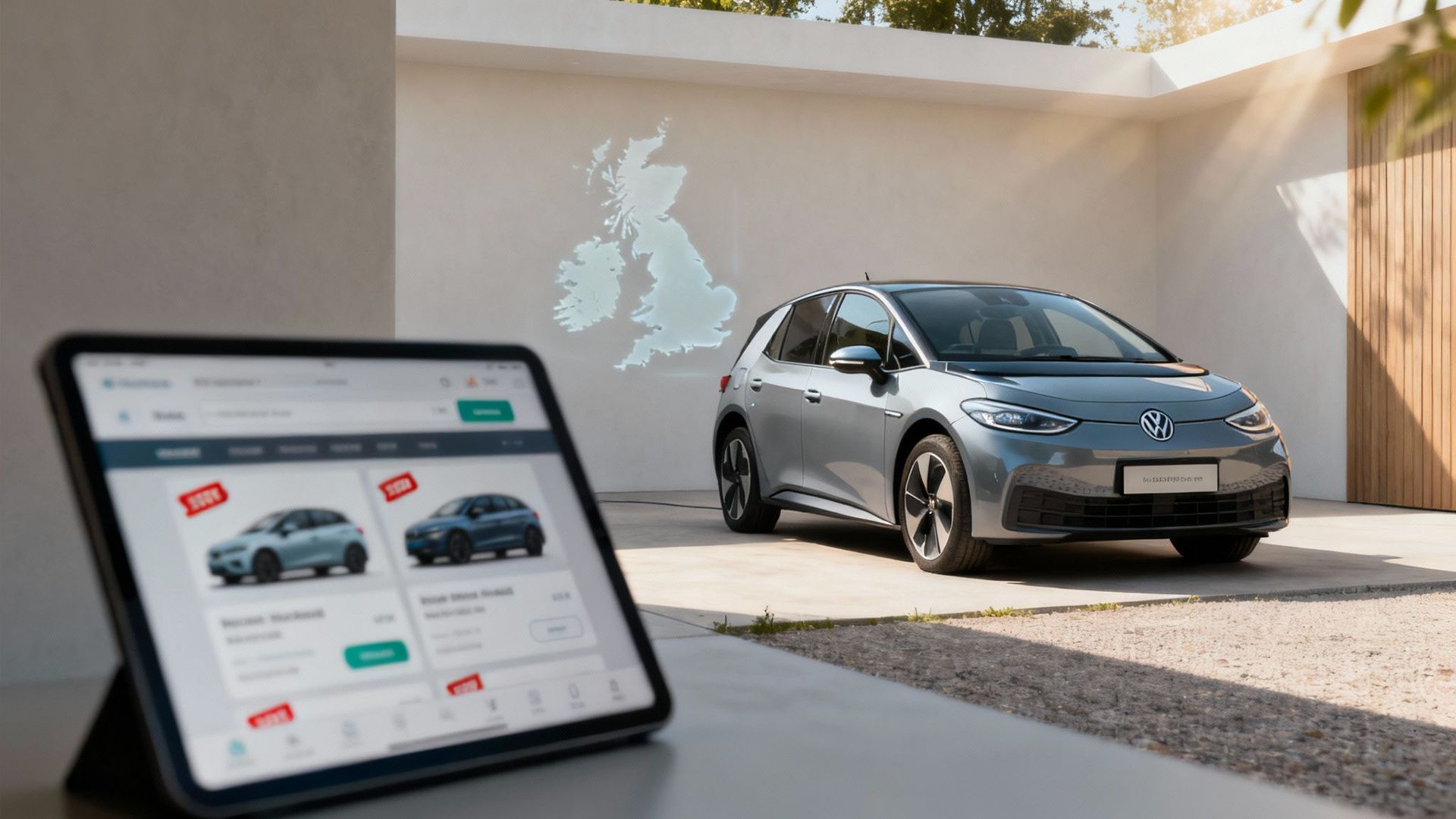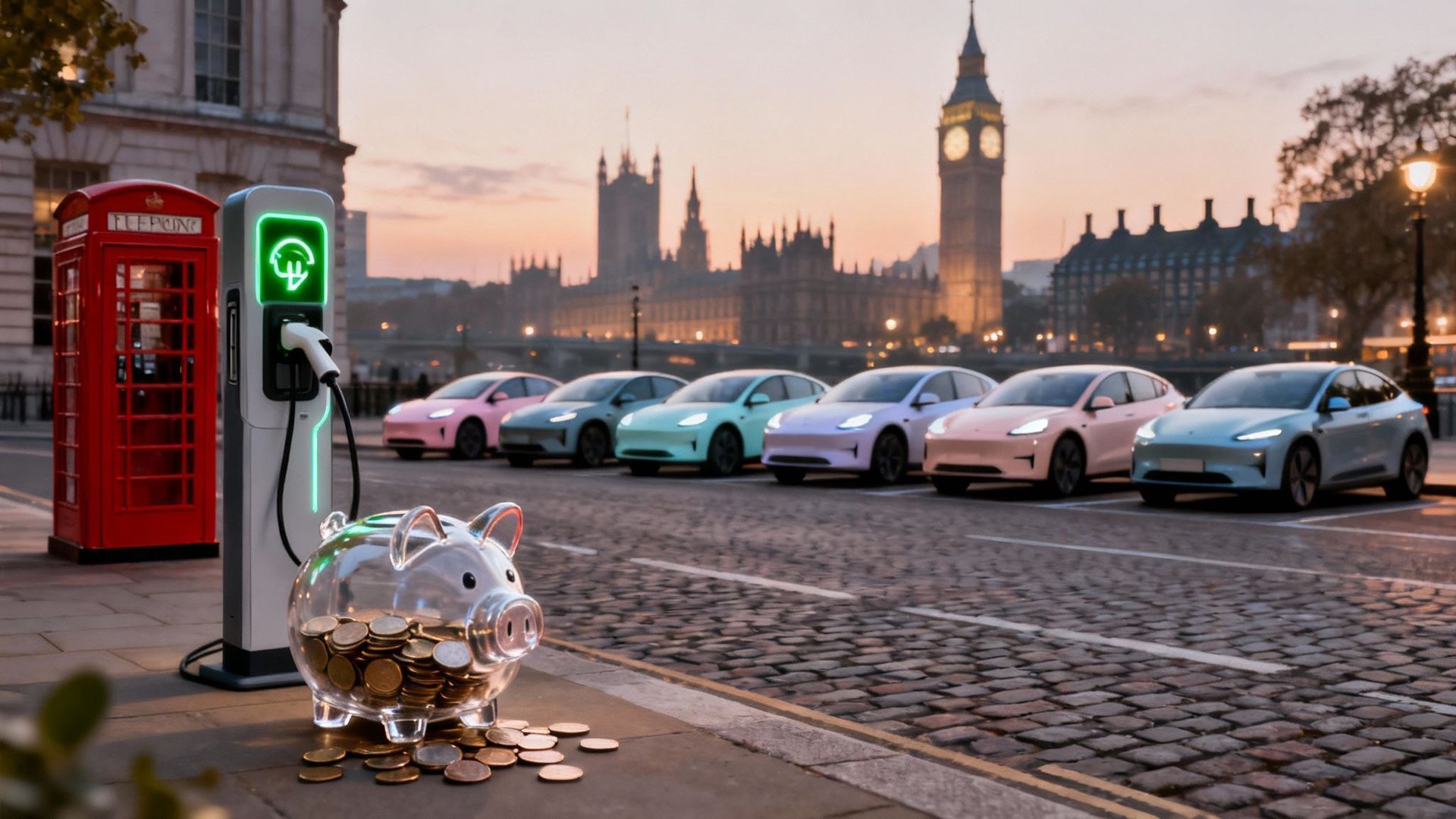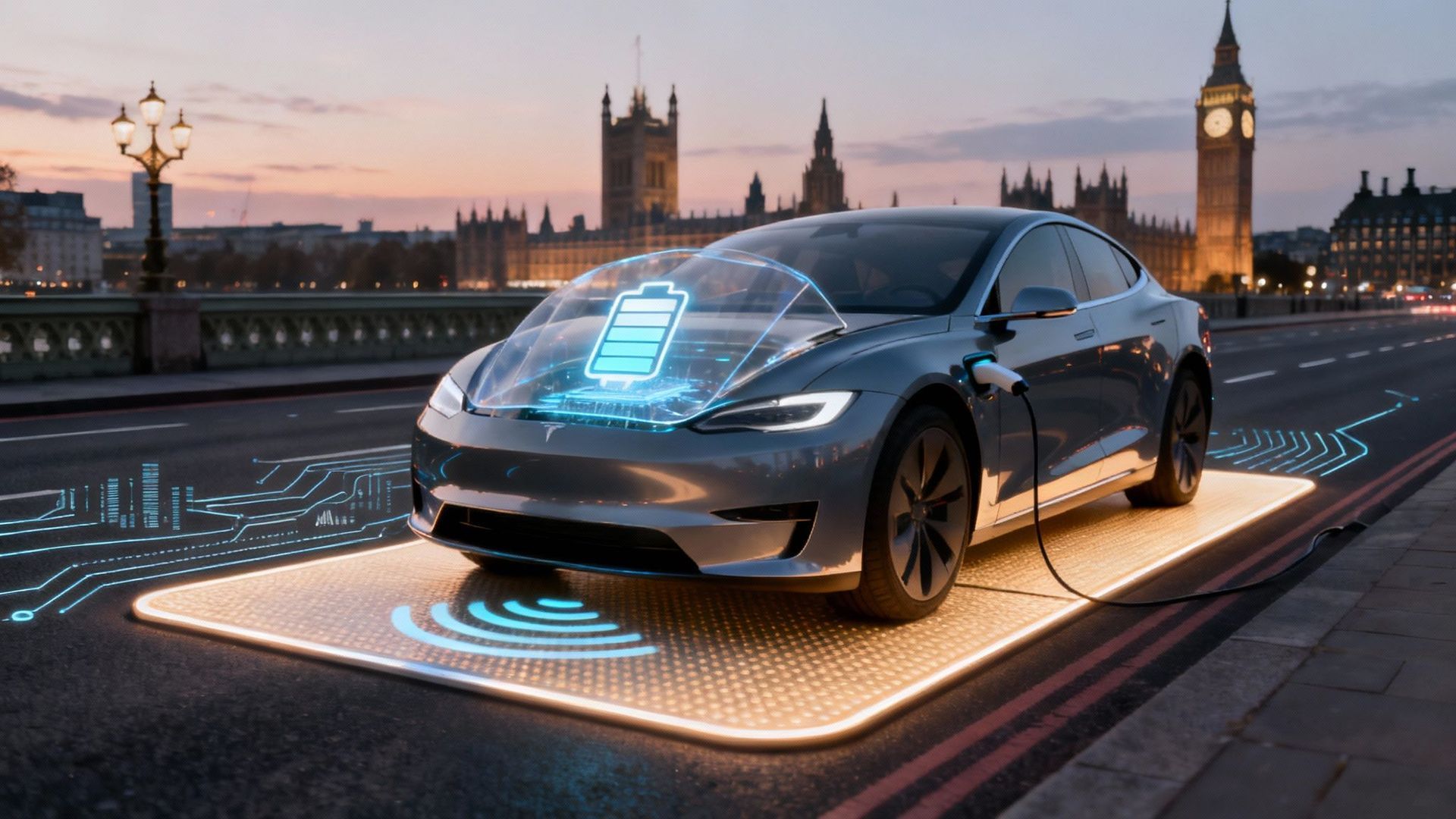The Audi TT Electric: Everything You Need to Know
Right then, let's pour one out for a true automotive legend. The Audi TT electric isn't just a rumour anymore; it's the inevitable, battery-powered successor to a petrol-slurping icon. Audi has officially called time on the combustion-engined TT, ending a glorious 25-year run, and is now deep in the process of grafting its spirit onto an electric chassis.
The End of an Era and an Electric Beginning
The Audi TT was always more than just a car. It was a bold design statement, a cultural touchstone that proved Audi could build something far more exciting than just another impeccably engineered saloon. From its Bauhaus-inspired debut back in 1998 , it became an instant classic. Many of us will remember seeing that first-generation model on the road and thinking it looked like a concept car that had escaped from a motor show.
Its demise, however, wasn't a surprise. In a world hurtling towards electrification, a quirky two-door petrol coupé is about as fashionable as a coal-fired smartphone. Audi, like every other manufacturer with a long-term plan, is going all-in on EVs. So, the TT had a choice: die a hero or live long enough to see itself become the electric star of a new generation.
Why the Change and Why Now?
The move to an Audi TT electric model is driven by one simple, unavoidable reality: legislation. With the UK and Europe tightening the screws on emissions, the days of the performance petrol engine are well and truly numbered. It’s a classic case of adapt or die, and Audi is choosing to adapt one of its most recognisable nameplates for a new, silent era.
The UK's long-standing love affair with the TT makes this transition particularly significant. It has been a huge market for the model right from the start, with British drivers snapping up over 157,000 of them across three generations. That incredible figure cements the UK as one of the TT's most loyal fanbases globally. You can read more about its impressive UK story over on Wheels-Alive.co.uk.
This isn't just a model update; it's a complete reinvention from the ground up.
The challenge for Audi is monumental: can they capture the playful, rebellious soul of the original TT and inject it into a heavy, silent electric platform? Or will the electric version be just another soullessly fast EV in a designer suit?
Let's take a quick look at how the old guard stacks up against the new kid on the block. While specs for the electric model are still under wraps, we can make some educated guesses based on the direction of the market and Audi's current technology.
Petrol Legend vs Electric Successor: At a Glance
| Characteristic | Classic Petrol TT | Anticipated Electric TT |
|---|---|---|
| Powertrain | 2.0-litre Turbocharged Petrol | Dual-Motor Electric |
| Sound | Characterful exhaust note & engine growl | Near-silent, with engineered sound |
| Performance Feel | Mechanical, raw, engaging | Instant, linear, relentless torque |
| Weight | Relatively lightweight & agile | Heavier due to battery pack |
| Design Ethos | Bauhaus-inspired, compact coupé | Sleeker, more aerodynamic, crossover-coupé? |
As you can see, the two cars are fundamentally different beasts. The real test will be whether the new electric model can deliver the same kind of emotional connection that made its predecessor such a firm favourite for a quarter of a century.
Decoding the Drivetrain and Performance Rumours
Let's get down to the brass tacks. An electric sports car that’s all show and no go is about as useful as a chocolate teapot. For the Audi TT electric to truly earn its badge, it needs to deliver the kind of electrifying acceleration that makes your passengers question their life choices. Forget the eco-warrior credentials for a moment; what everyone really wants to know is, will it be quick?
The rumour mill is spinning faster than a turbocharger on full chat, and the biggest question is what lies underneath. Audi has a few options to pick from in the vast VW Group toy box. The most exciting possibility is that it will borrow from its posh cousin, Porsche, by using the platform from the upcoming electric 718. This would mean a purpose-built, performance-focused architecture designed for a low-slung sports car, not a repurposed SUV chassis. Think of it as getting a bespoke suit instead of one off the peg.
This infographic shows the conceptual journey of the Audi TT, charting its evolution from a petrol-powered legacy to a fully electric future.
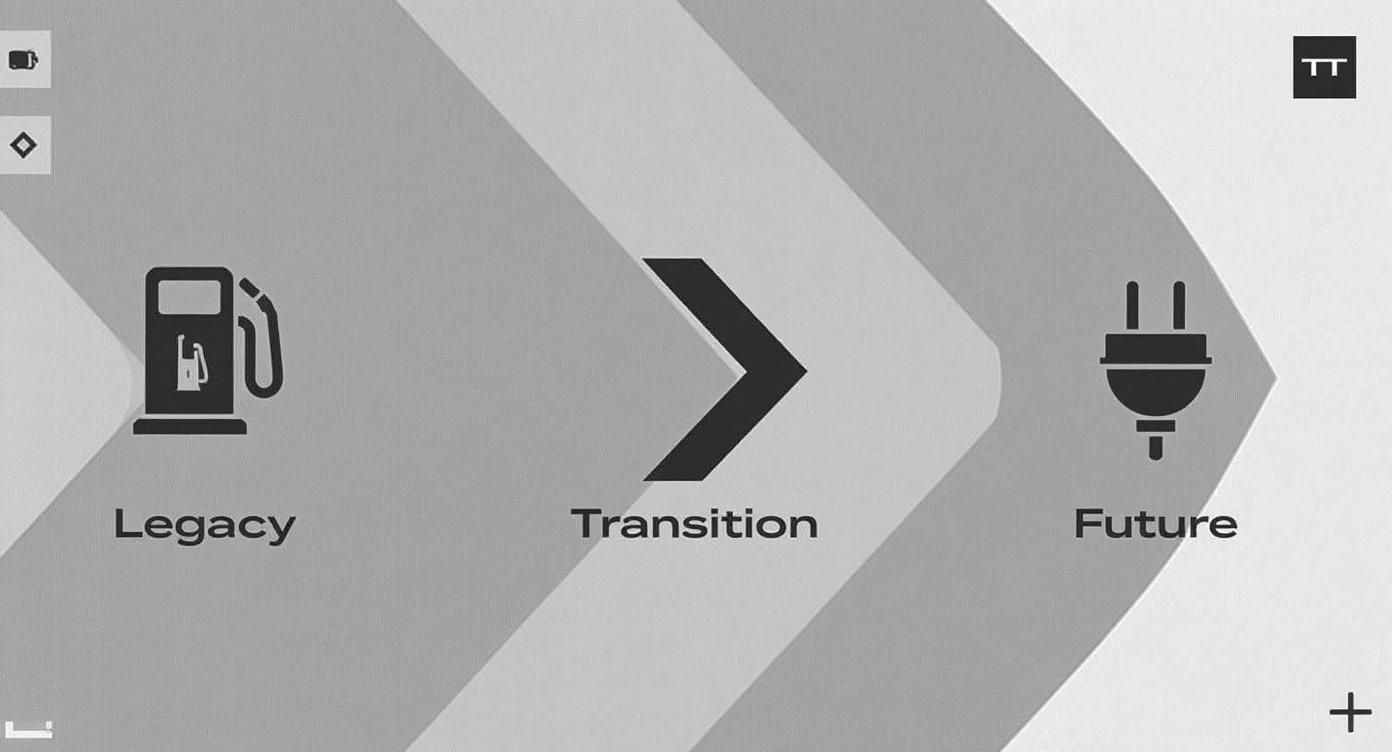
It’s a neat visualisation of the car’s path from a familiar past to a plugged-in, high-voltage destiny, marking a fundamental shift in powertrain technology.
Performance Speculation
So, what kind of numbers can we expect? While Audi is keeping its cards close to its chest, insiders are hinting at performance figures that would leave the old petrol models for dead.
- 0-60 mph Time: A sub-four-second time is almost a given. Anything slower would feel like a let-down, with many speculating a blistering 3.5-second sprint is the real target.
- Powertrain: A dual-motor, all-wheel-drive setup seems inevitable. This isn't just for all-weather grip on miserable British B-roads; it’s for deploying that sledgehammer torque instantly and efficiently.
- Battery & Range: We're likely looking at a battery capacity of around 80-90 kWh . In the real world, that should translate to a range of about 280-320 miles —more than enough for a proper Sunday blast without a panic-inducing search for a charger.
The battery is the heart of any EV, and its chemistry and packaging are crucial for both performance and range. If you want to dive deeper into the science, you can do so by exploring the latest innovations in electric vehicle battery technology in our detailed guide. This tech is what determines how quickly the car can charge and how consistently it can deliver power without overheating.
The core challenge isn't just making the Audi TT electric fast in a straight line. It's about ensuring the car feels agile and responsive, masking the inevitable weight penalty that comes with cramming hundreds of kilograms of batteries into a compact frame. It needs to dance, not just drag race.
Will the Iconic TT Design Survive Electrification?
Let’s be brutally honest for a moment. The original Audi TT was a design masterpiece. It was a perfect slice of Bauhaus-inspired genius that looked like it had driven straight off a concept sketchpad and into your local Audi showroom. Minimalist, perfectly proportioned, and just undeniably cool. The big question now is, can Audi’s designers capture that lightning in a bottle again for the Audi TT electric , or are we destined for another anonymous, jelly-mould EV?
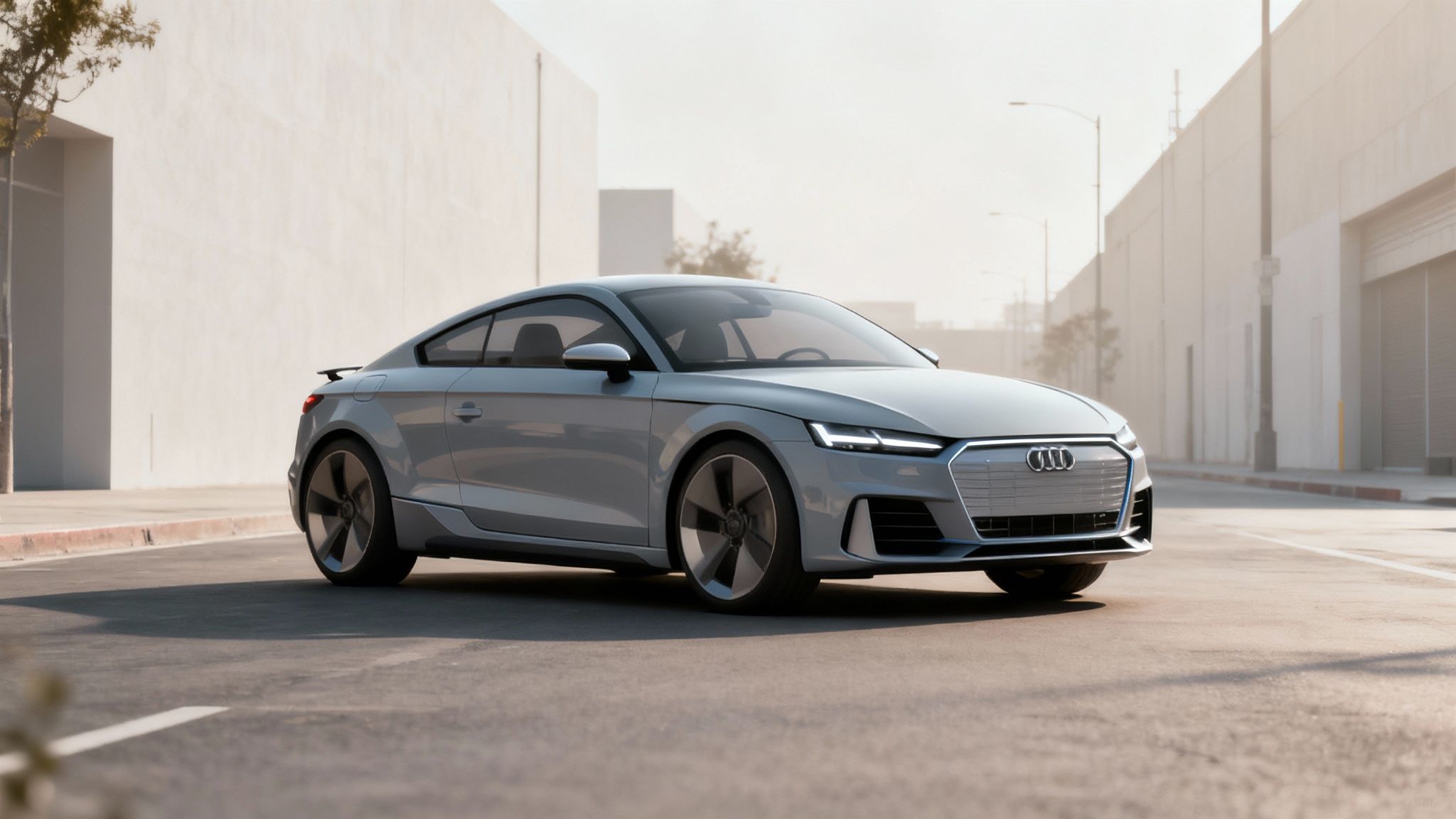
The pressure is immense. Reimagining an icon is a thankless task. Get it right, and you’re a hero. Get it wrong, and you’ve just desecrated a sacred relic for a generation of car enthusiasts. It’s like asking a Michelin-starred chef to reinvent the Pot Noodle; the potential for disaster is enormous.
A New Face for the Electric Age
Think about it: one of a car's most defining features is its grille. For an EV, this creates something of a philosophical crisis. With no massive petrol engine needing to be cooled, a traditional grille is about as necessary as an ashtray on a motorbike. We’ve seen Audi's current e-tron models opt for a large, closed-off ‘Singleframe’ grille, which can look a bit like a car that’s forgotten to take its face mask off.
For the Audi TT electric , we have to expect something similar, but hopefully with more finesse. The real challenge is creating a distinctive front end that screams "Audi" without looking like a featureless blob. Aerodynamics will be king here, so expect a low, slippery nose and an obsession with airflow that would make a Formula 1 engineer proud.
Following the reveal of the Concept C, the electric Audi TT is expected to debut around September 2025 . It’s set to be the flag-bearer for Audi's new design language, which is all about sophistication and sustainability. This will be the moment of truth, where we see if this new direction can truly honour the TT’s legacy. You can read more about Audi’s design future from their official press release.
The Silhouette: A Make-or-Break Moment
The classic TT silhouette is its calling card—that beautifully curved roofline and its compact, muscular stance. But electric platforms bring their own set of design rules. A big, flat battery pack under the floor has a nasty habit of raising a car’s entire profile, pushing it towards a bloated crossover shape. Frankly, that's the ultimate nightmare scenario for the new TT.
The greatest fear is that Audi will chicken out and turn the TT into a "sporty crossover coupé". If they do, it’s not a TT anymore. It’s just another high-riding electric appliance for people who’ve given up on life but still want to get to Waitrose quickly.
To succeed, the designers must fight tooth and nail to keep that low-slung, compact profile. It has to be instantly recognisable as a TT, even from a hundred paces. Anything less would be a catastrophic failure. Yes, the tech-focused, minimalist interior an EV allows is a given, but the soul of this car lives in its exterior shape. Here’s hoping they haven’t lost the plot.
The UK Market: Can the Electric TT Really Succeed Here?
An electric sports car sounds brilliant on paper, doesn't it? Silent, neck-snapping acceleration from the lights, and that smug satisfaction as you glide past petrol stations. But let’s get real for a moment. This is Britain. Our roads have more craters than the moon, our weather is reliably grim, and our public charging network can be, to put it mildly, a bit of a lottery.
So, how will the new Audi TT electric actually cope on our shores?
Slapping a battery and a motor into a sports car shell and calling it a day just won't cut it. The UK market is a brutal arena, and success here demands more than a fancy spec sheet. For many people, EV ownership is still a leap of faith, filled with anxiety about finding a working charger on a wet Tuesday in Stoke. For a proper look at the glorious highs and frustrating lows, you can explore the realities of electric vehicle ownership in the UK in our full guide.
The challenge for the electric TT isn't just about logistics, either; it's cultural. Britain has a deeply ingrained petrolhead community, a group that cherishes the noise, the smell, and the mechanical theatre of a combustion engine. Can a silent, almost sanitised electric sports car ever truly win them over?
The Charging Conundrum and an Onslaught of Rivals
Let’s talk charging. Yes, the network is growing, but the experience can still feel like a postcode lottery. Finding an unoccupied, functional, high-speed charger right when you need one is far from guaranteed. For a car that’s supposed to be about exhilarating B-road blasts, having to plan your fun around the charging infrastructure feels like a bit of a buzzkill.
Then you’ve got the competition. By the time the electric TT actually arrives, it will be driving straight into a seriously crowded field. Porsche is readying an electric 718, and you can bet that brands like Alpine and others will be throwing their hats into the ring. Audi can't just slap the TT badge on the bonnet and expect it to sell; this car will need to be truly exceptional to stand out.
Here's a quick look at how the battleground might shape up.
How the Electric TT Stacks Up Against UK Rivals
| Feature | Speculated Audi TT Electric | Porsche 718 EV (Expected) | Alpine A110 E-ternité (Concept) |
|---|---|---|---|
| Drivetrain | Dual-motor AWD (expected) | RWD/AWD options | RWD |
| Power Output | ~450-500 bhp | ~500-600 bhp | ~239 bhp |
| 0-62 mph | <4.0 seconds | <3.5 seconds | 4.5 seconds |
| Est. Range | ~280 miles | ~250-300 miles | ~261 miles |
| Key Selling Point | Iconic design, Audi tech | Unmatched driving dynamics | Lightweight, agile handling |
While Audi brings brand loyalty and a beloved design, the competition from Porsche, in particular, will be ferocious, promising even sharper performance.
The real question comes down to value and desire. Will the price position the electric TT as a niche plaything for the Knightsbridge set, or can it appeal to the traditional sports car buyer who saves up for years for their dream machine? If it's priced too high, it risks becoming irrelevant before it even hits the showroom.
Historically, the UK has been a massive market for the TT. Its popularity here has been immense, with some specific right-hand drive models selling around 900 units in the UK out of a global production run of just 1,165 . That shows a dedicated and enthusiastic customer base.
Audi will be desperately hoping that this historic loyalty translates to the electric era, but it's a monumental gamble. The heart wants what it wants, and for many UK drivers, that heart still beats to the rhythm of a petrol engine.
The Pros and Cons of an Electric Sports Car
Let’s be honest, swapping the snarling petrol engine of a beloved sports car for a silent battery pack isn’t just a simple upgrade. It’s a full-on personality transplant, and it brings a whole new set of rules to the game. Here’s a brutally honest look at what you gain and what you lose when a car like the Audi TT electric ditches fossil fuels for volts.
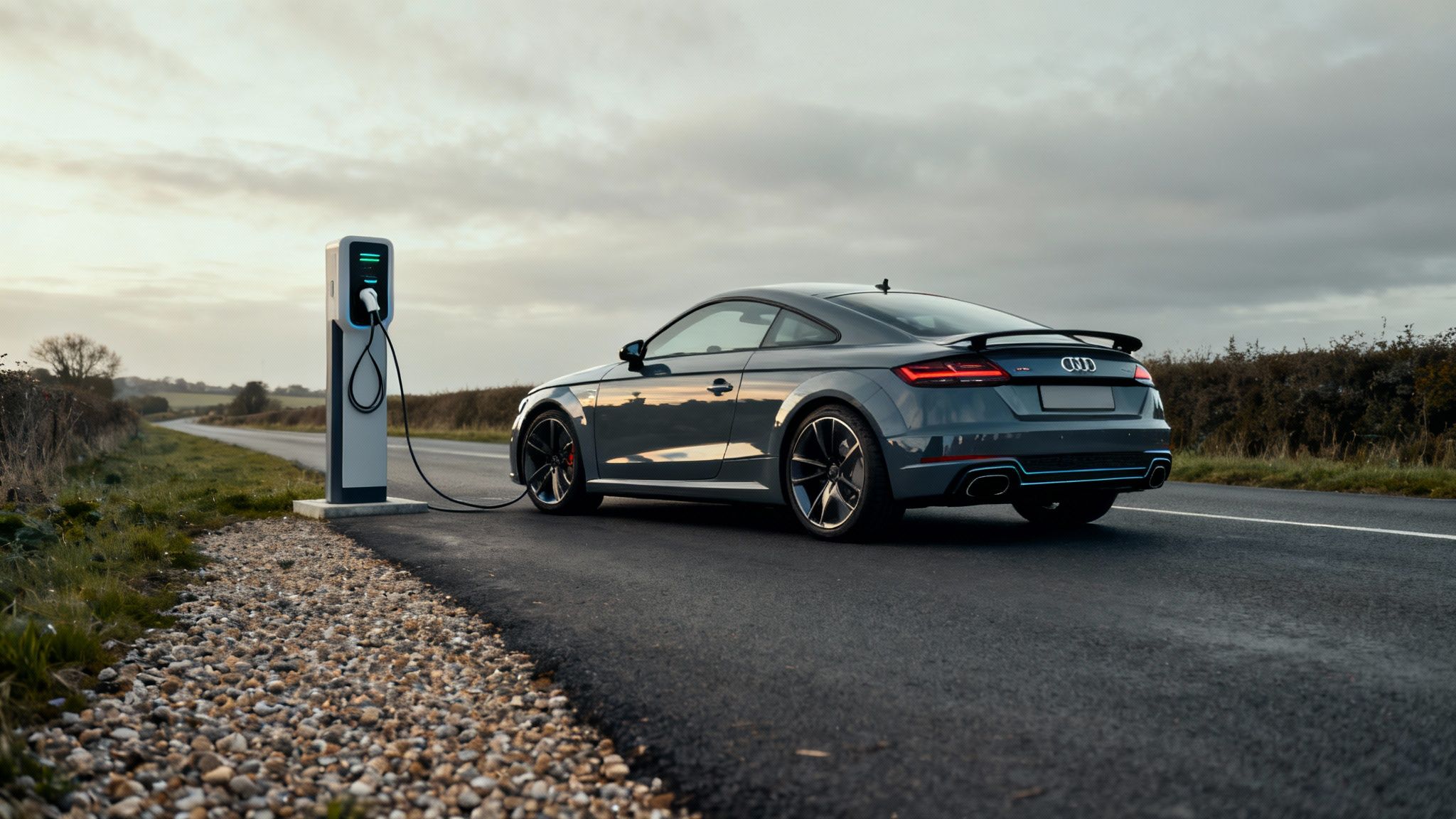
On the one hand, the upsides are undeniably potent. The most obvious party trick is the performance. Electric motors deliver all their power, all at once. That means the acceleration isn’t just fast; it’s a savage, relentless, and almost unnervingly silent shove in the back. It makes a traditional petrol car feel a bit, well, sluggish off the line.
Then there’s the handling. By stuffing the heavy battery pack low down in the floor, you give the car a centre of gravity a snake would be jealous of. This translates to incredibly flat, stable cornering that can make an average driver feel like a hero on a twisty B-road.
The Good: Silent, Smug, and Seriously Quick
The advantages of going electric in a sports car are compelling, especially when you look beyond the raw numbers.
- Instantaneous Power: No waiting for turbos to spool or gears to shift. You think it, it goes.
- Lower Centre of Gravity: That battery placement fundamentally improves stability, gluing the car to the road through the corners.
- Zero Tailpipe Emissions: You get to enjoy some guilt-free fun, feeling smugly superior at every set of traffic lights.
- Reduced Running Costs: Swapping pricey petrol station visits for overnight top-ups at home is a massive win for your wallet.
But it’s not all sunshine and silent burnouts. The switch to electric power comes with a hefty dose of compromise, and anyone who pretends otherwise is probably trying to sell you one.
The Drawbacks: Soul, Silence, and a Sense of Heft
The biggest complaint you’ll hear from proper petrolheads is the complete and utter lack of noise. A sports car's soul is so often tied to the sound of its engine—the crackles, the pops, the roar as it climbs the rev range. An EV offers none of that mechanical theatre, just a faint whine that’s about as emotional as a milk float.
Weight is the other elephant in the room. Batteries are fantastically heavy, and while clever engineering can mask it, you can't defy physics forever. That extra bulk can make a car feel less nimble and more brutal, bludgeoning the road into submission rather than dancing over it. And, of course, there’s the ever-present spectre of range anxiety, which feels particularly cruel when you’re miles from home on a perfect Sunday drive. If you're weighing the options, you can see a rundown of the best electric sports car contenders for 2025 and see how they all stack up.
The dilemma is simple: Do you crave the raw, visceral, and slightly inefficient drama of a combustion engine, or are you ready for the brutally efficient, silent, and almost surgically precise performance of an EV? The Audi TT electric will force drivers to pick a side.
Your Guide to Buying the Audi TT Electric in the UK
Right, so you’re sold. You’ve pictured the silent acceleration, the admiring glances, and that feeling of having one of the first electric sports car icons on your drive. Now for the slightly less glamorous part: actually getting your hands on one.
If you think you can just wander into your local dealership and drive an Audi TT electric away, you might need a strong cup of tea and a bit of a reality check.
Buying a highly anticipated, low-volume car like this is less of a purchase and more of a campaign. First up, you’ll need to get on the "expression of interest" list. This is essentially Audi's way of filtering out the window shoppers from the serious buyers. From there, it’s a waiting game until the official order books open, at which point you’ll need to be quicker than a caffeinated greyhound to secure a build slot with a hefty deposit.
Navigating the Inevitable Waiting List and Price Tag
Let's not mince words here: the waiting list is going to be long. Early adopters and die-hard TT fans will be falling over themselves to get to the front of the queue. Realistically, you should expect a wait of at least 12-18 months from the moment you place your order to the car actually arriving. Patience isn't just a virtue in this game; it's mandatory.
Then there’s the price. While Audi is keeping its cards close to its chest, a starting figure of around £65,000 for a base model seems plausible. Expect the higher-spec versions to easily nudge past £80,000 , and that’s before you even glance at the optional extras.
Be prepared for Audi’s legendary options list. It’s a financial minefield designed to separate you from your savings. Fancy that gorgeous paint colour you saw in the brochure? That’ll be £2,000. Want the upgraded sound system and those stunning 20-inch wheels? You’d better find another few grand down the back of the sofa.
This isn’t just about buying a car; it’s an investment in being one of the very first. You’ll need to prepare for both the financial hit and the logistical marathon of securing one. My advice? Start cosying up to your local Audi dealer now—it might just be the smartest move you make.
Your Questions Answered
Alright, let's tackle some of the biggest questions we hear about the all-electric Audi TT. Here are the straight answers you've been looking for.
When Can I Actually Buy One in the UK?
Audi is keeping its cards very close to its chest on this one. All the signs and industry whispers, however, point towards a grand reveal sometime in 2025 , with cars potentially hitting UK roads by 2026 . So, while you can't place a deposit just yet, it might be a good time to get friendly with your local Audi dealer.
How Much Is This Going to Cost Me?
Official pricing is still under lock and key in Ingolstadt, but let's be realistic—it's going to carry a premium price tag. You should probably expect a starting figure somewhere north of £65,000 . It certainly won’t be cheap, but that kind of head-turning style rarely is.
The big question on everyone's mind: Will the electric TT actually be fun to drive? It'll be monstrously fast, no doubt. But 'fun' is subjective. If you crave engine noise and the smell of petrol, you’ll be disappointed. If your idea of fun is silent, savage acceleration, then yes, you'll probably think it’s absolutely brilliant.
Will There Be a Convertible Roadster Version?
It would be a huge surprise if there wasn't. The TT is just as famous for its drop-top version as it is for that iconic coupé silhouette. For Audi to ditch the roadster would be like having fish without chips—it just wouldn't feel right. We fully expect a convertible to follow shortly after the main launch.
Ready to explore the future of electric driving? VoltsMonster has all the honest reviews, news, and guides you need to navigate the world of EVs. Dive into our content today at https://www.voltsmonster.com.

